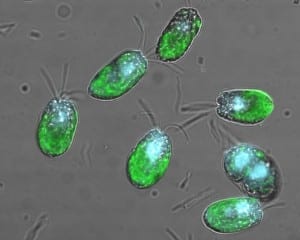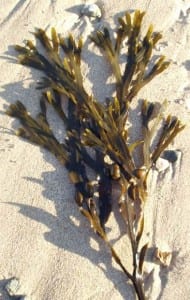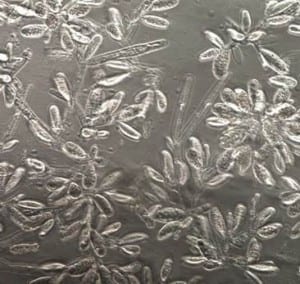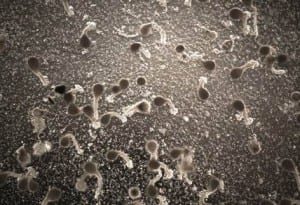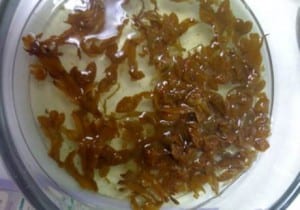Over the course of my Ph.D. I have had the chance to experiment with different ideas related in some way to my field. Some of these ideas do not fit well into the ‘scientific story’ that will eventually become my thesis, however the ideas are still simmering away on the back burner, and will hopefully develop in future.
High-Speed Camera Fun!
My Ph.D. focuses on how phytoplankton swim in a range of environmental conditions. The best way I can describe what these cells look like is to imagine a grape with 4 whiskers sticking out the top…
These ‘whiskers’ are called flagella and are what the phytoplankter use to swim. The flagella themselves are tiny, measuring only 8µm long (about 1/10th of the width of a human hair) andbeat 65 times a second (for reference, Hummingbirds beat their wings at 70x second).
To record the rapid movement of the flagella, we attached a high-speed camera (very carefully I might add, it costs the same as a new BMW 3 series!!) to our Zeiss inverted microscope. The camera itself can achieve a frame rate of around 70,000 frames per second (fps) (the camera on your phone probably records at 30fps); however this speed far exceeded our requirements…but we still had to have fun with it!
Below is a video we recorded at 6400 fps of a falling water droplet. Best viewed in HD and full screen!
.
Let there be light!
Since I had room in the orbital shaker, I acquired some bio-luminescent phytoplankton (Pyrocystis fusiformis) as a cool pet to have. These cells respond to turbulent water movement by lighting up, and at certain times of the year on the California coast appear in large algae blooms, creating a breathtaking lightshow at night (Search “Red Tide – Bioluminesence” on Youtube, its like something out of Avatar!).
Test-tube babies! How to grow Seaweed in a Petri-dish
Continuing on the theme of ‘small things swimming’, I became interested in the reproductive cycle of Fucus species of seaweed. Fucus is the stereotypical seaweed that you imagine on British Shores. Long, brown-green plants that drape over the rocky-shore and sometimes make a popping noise as you step on their gas bladders.
Something that not many people consider is how seaweed reproduce. They cannot do it in the same way terrestrial plants do as there are no pollinators in the sea. Instead, male Fucus release tiny swimming sperm into the water (usually coinciding with a full or new moon) that locate an egg using a rudimentary eye…yes, you heard me right – seaweed release sperm that can see! Seaweed sperm have a simple eyespot which (it is thought) allows them to detect light from the moon; and as the eggs are negatively buoyant (posh word for ‘sink’), the sperm swim down and away from the moonlight to locate the female egg. To this day this fact still blows my mind (probably much to the annoyance of the 1st years I help teach shoreline ecology to).
So, I was interested in how temperature (and subsequently, viscosity) effect reproductive success of these plants. Below is an image of Fucus conceptacles – little sacks that either contain 8 female eggs or 64 sperm cells (in this case they are all male).
After some special treatment (which may or may not have involved Candles and a Barry White CD), the sperm and eggs were collected and mixed together in Petri dishes. Below is a video I took once the sperm and eggs were mixed. The egg is rotating due to the sperm trying to burrow into the egg.
After 10 days, the fertilized eggs became rhizomes – tiny little baby seaweed!
And after a while I soon ran out of space as they young plants filled their petri dishes. Sadly, I cannot find the pictures I took of this (I know my supervisor will shake his head reading this), so I have borrowed one from Lena Katuskys group at the University of Stockholm).
Until next time 🙂
